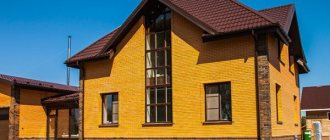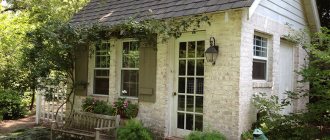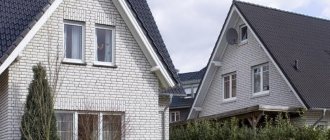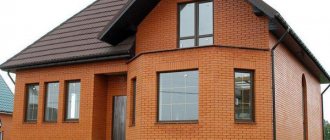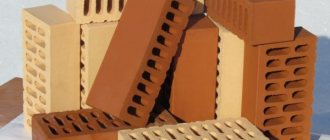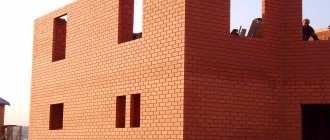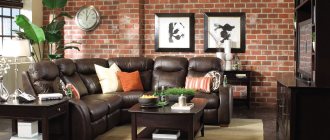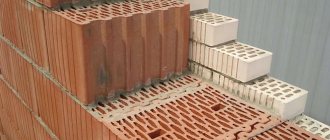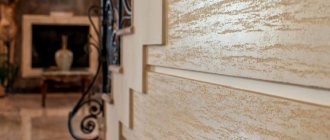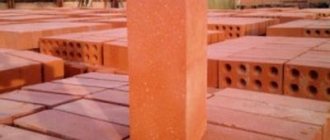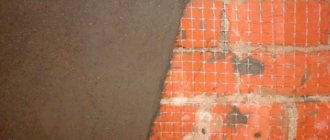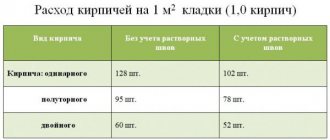Brick is considered the most reliable material for external cladding of facades.
The material is distinguished by its strength, ability to withstand external influences of an aggressive environment, durability and environmental friendliness.
Brick material can have different compositions, and therefore the color of different types differs from each other.
Also, depending on the composition, the brick has different properties, prices, and characteristics.
To decorate the structure in a non-standard version, yellow brick is used.
Classification of facing bricks
The gradation of façade cladding is determined by its manufacturing technology.
There are four categories of facing bricks:
- Ceramic.
- Clinker.
- Hyper-pressed (concrete).
- Silicate.
Brick in each of the listed categories is available in two versions: solid and hollow. The weight of hollow core brick is on average 25-35% less, and its resistance to heat loss is approximately 10-15% higher.
Ceramic facing brick
It is produced by firing a raw material mixture consisting of red fusible clay, organic and mineral additives that regulate plasticity. Coal dust, slag, fireclay, sawdust, ash and quartz sand are used in this capacity. The initial mixture successively goes through the processes of molding, drying and firing. The main difference between facing ceramic bricks and ordinary ones is the careful preparation of the components before molding. Therefore, there are no foreign inclusions or cracks in it.
The material obtained at the exit from the firing chamber is resistant to moisture, high strength and good energy-saving qualities. The types and colors of ceramic facing bricks are varied.
On sale you can find not only ordinary, but also shaped material (for laying complex architectural elements). To expand the color range, manufacturers use mineral dyes (chromium oxide, finely ground iron or manganese ore), adding them to the composition of the feedstock.
Decorating the surface of ceramic bricks is done in several ways. In addition to the smooth matte and shiny surface, finishing options are available that give this material a resemblance to wild stone.
Clinker brick
The closest “relative” of ceramic brick. The main difference between them is the raw materials and firing temperature. Medium and refractory clays are used to produce clinker. Accordingly, they are fired at a higher temperature. The result is a very dense and durable facing brick with minimal water absorption. These qualities make it possible to use it not only in facade decoration, but also for cladding the base of the foundation, building fences and paving paths.
The thermal conductivity of clinker stone is higher than that of ceramic stone. This disadvantage is compensated by its high resistance to cracking under the influence of low temperatures.
The color palette and texture of clinker stone are extremely diverse, since each manufacturer offers customers its own collections. The size range of this cladding also cannot be called boring. In addition to the standard single version 250x120x65 mm, you can buy bricks of reduced thickness and height, as well as long clinker (528x108x37 mm).
Hyperpressed brick
Firing clay is an energy-intensive process and not very profitable. Therefore, many manufacturers are switching to pressed unfired bricks. Its basis is granite screenings, water and cement. At its core, it is super-dense concrete, which has been shaped into masonry bricks.
The main requirement for façade finishing is resistance to weathering. According to this indicator, hyper-pressed brick is perfect for finishing external walls.
In terms of strength and other quality characteristics, it is practically not inferior to clinker. Thanks to the texture of the surface (rock, torn stone) and the use of persistent dyes, this material looks excellent in masonry.
Finishing the facade with hyper-pressed brick looks elegant, solid and reliable
Sand-lime brick
Belongs to the category of non-firing materials. It differs from hyperpressed brick in its raw material composition. There is no cement in it. High mechanical strength is achieved here by hardening a mixture of silicate sand and slaked lime in an autoclave (high temperature and pressure).
Nowadays, silicate facade brick as a facing material is losing its former popularity. In the struggle for buyers, manufacturers have developed several color options for the silicate mixture. Unfortunately, they all look rather pale and cannot compete with the rich colors of ceramics and clinker.
This material behaves well in building cladding. Compared to clinker bricks, they absorb moisture more strongly, but at the same time, they can withstand repeated soaking, freezing and thawing better than ceramics.
Figured (shaped) brick
Today, no one is satisfied with the straight lines of the facade, so each type of facing brick is complemented by a wide range of shaped elements. Using them, you can lay out complex architectural elements without laborious hewing and cutting, dressing your house in a beautiful “stone lace”.
Advantages and disadvantages
An undeniable positive property of yellow brick is its decorative effect. A house whose façade is made of yellow brick will always stand out among other buildings.
In addition, this material has other advantages:
- good sound insulation;
- color fastness . The coating does not fade and is not exposed to sunlight;
- does not require special care, does not attract dirt, and also prevents the formation of mold or fungi;
- frost resistance. This type of cladding can be used in any region, regardless of temperature;
- strength . When exposed to any mechanical and impact actions, the cladding remains unchanged, does not deform, does not crack;
- resistance to any weather conditions. Rain, hail, and strong winds cannot negatively affect brick cladding;
- hydrophobicity. The production technology ensures the material is moisture resistant and incapable of absorbing moisture;
- fire resistance . Brick does not burn and does not support combustion in any way, does not ignite or melt;
- environmental friendliness. Due to the use of natural components in manufacturing, brick cladding is absolutely harmless to humans;
- durability _ The cladding may not lose its properties for many years; in comparison with suspended facade structures or decorative coatings with plaster or paint, it is the most durable and wear-resistant.
The disadvantages of brick cladding include cost, since the material is quite expensive compared to other types of external cladding . In addition, yellow brick is not varied enough in shape: the main element of the yellow type is a parallelepiped.
Brick photo:
Characteristics of yellow brick: what to look for?
Composition and properties
The bricks are made in standard sizes and yellow in color. High-quality material is made from several types of raw materials: a mixture of limestone, cement and iron oxide. The result is a light yellow tint. These ingredients are pressed into a mold and dried. This material is called silicate. Yellow ceramic bricks are made from dye and clay. This type is popular for large houses. Clay, which cannot be melted, produces yellow clinker building material. Clinker is a fireproof and waterproof resource for construction. Country houses are built from it because clinker material is frost-resistant. So, because of the fireclay it contains, they called it yellow fireclay brick. It has a rough surface and a variety of shapes.
Varieties of yellow facing bricks
- Full-bodied. Facades and interior walls are made from it.
- Hollow. It is in much greater demand because it has thermal insulation properties. During construction, the size of the material plays a role.
The hollow type of product is divided into two types, more details about which are in the table:
| Name | Dimensions |
| Single | 200×100×60 |
| One and a half | 200×100×82 |
In practice, builders buy the one and a half type, because much less of it is needed for construction. The shape of the building material gives importance. They are:
- rectangular, which are used for external walls or internal partitions;
- curly - for window openings, arches or supports.
Products are also divided according to the type of surface, which can be:
- Smooth. Provides an attractive view outside and inside the house.
- Corrugated. Needed to create an unusual appearance and originality.
- Decorative. It is decorated with drawings and used in the interior of the house.
Popular types of ceramic products
- Facing (facing brick and facade). Durable, mechanically stable. There are dark and light bricks.
- Glazed. It is characterized by a glazed coating, ease of maintenance and a long period of operation.
- Double layer type. A clay layer is applied to the workpiece, which is fired. This creates twice as strong protection for the product.
- Engobed. The base is a high-strength clay mixture. This product is not susceptible to external influences.
Types of ceramic bricks
- Engobed. It has a decorative layer consisting of white clay, powdered glass and dyes. Burns once. The stone comes out matte with an even shade. Angobe brick is used to effectively decorate walls indoors and outdoors.
- Glazed. This brick has a glossy surface. During the production process, a colored glaze is applied to the pre-fired workpiece. This is a melting composition of glass chips. The product is subjected to secondary firing at a temperature of 700°C and covered with a glassy layer.
- Double layer. This is a ceramic brick, the thin outer layer of which consists of clays that acquire a pink-beige hue when fired. Its base consists of simple clays.
Silicate varieties of building materials
For their production they use:
- lime;
- quartz sand;
- plasticizers;
- additives.
This composition ensures safety and indicates the environmental friendliness of the material.
One-and-a-half (silicate) yellow brick is made from 10 percent lime and 90 percent sand and is subjected to steam and high-temperature treatment. This method is called autoclave. Products made from this material get their color depending on what dyes were used. As a result, the shades of brick can be very different.
There are 2 types of silicate brick products for facade finishing:
- Double. Provides high thermal insulation;
- Front with decorative surface. Provides excellent appearance.
A significant feature of finishing with silicate products is that they do not tolerate high humidity and low temperatures. Therefore, this option will not be relevant for every territory of our country. For example, in northern regions, as well as those characterized by high groundwater, this type of finishing material is completely unsuitable. There it is more advisable to choose a ceramic analogue. Under the same conditions, it will provide the same properties as silicate building materials and will last much longer. That is, for them the best solution is ceramic one-and-a-half bricks.
Construction portal No. 1
The debate about which houses are better - one-story or two-story, it seems, will never subside. They alternately give way to each other in the struggle for popularity, since each option has its own advantages and disadvantages.
Two-story houses and cottages allow for the most reasonable use of the site area, which is especially important in cases where there is a shortage of free territory. The presence of a second floor allows you to delimit functional areas - for example, bedrooms can be located on the second floor, and common rooms and a kitchen will be located on the first floor. And, of course, two-story houses usually have a more luxurious and status-rich appearance.
The issue of saving during the construction process is also important, but if two-story houses allow you to save on materials for the roof, then one-story houses are cheaper in many respects, ranging from the cost of project development to the cost of laying internal communications.
In general, the construction of a one-story cottage requires less money, but in addition to this, other positive aspects cannot be ignored. Firstly, a one-story house will be built much faster, due to the fact that the construction technology is simpler. Secondly, such a house will subsequently be easier and cheaper to maintain. Thirdly, the stairs to the second floor create certain inconveniences for older people and are a potential source of danger for both old people and young children. And finally, in one-story houses the effect of a single space is created, which has a beneficial effect on the psychological climate of the family.
Peculiarities
Facing brick is a universal finishing material that allows you to hide flaws in the brickwork of load-bearing walls, additionally insulate the facade and give the building an impressive and noble appearance. A house lined with decorative brick becomes the center of attention and looks very presentable. The main difference between face stone and ordinary silicate or ceramic products is the surface texture, color scheme and composition.
High consumer demand for facing material is due to a number of its undeniable advantages. Among them, one can highlight the high decorative properties of brick, which is explained by a wide color palette and a wide variety of shapes, textures and designs. In addition, the lined surface significantly reduces heat loss in the premises and does not allow extraneous noise from the street to penetrate inside.
The advantages include the high thermal stability of most models, as well as their ability to withstand sudden temperature changes. The brick-lined façade tolerates conditions of high humidity well and is not afraid of frequent and prolonged rainfall. Due to the high resistance of the facing stone to aggressive environmental conditions, the material can be used in any climatic zones, including areas with a sharply continental climate and northern territories.
However, along with numerous advantages, the material has a number of disadvantages. The disadvantages include the risk of excessive load on the foundation, the high cost of some types and the need to use expensive adhesive mixtures for cladding. The scope of use of facing bricks is quite extensive. In addition to cladding the base and facade, the material is actively used in the construction of fences and columns, as well as for finishing small architectural forms: arches, gazebos and garden fences.
All facing stone is available in 2 versions: solid and hollow. Hollow models weigh 30% less than their solid counterparts and have higher thermal insulation characteristics and a lower price. The use of hollow bricks increases the heat-saving properties of the cladding by 15% compared to the use of solid products. Therefore, when using solid models as finishing, the necessary measures should be taken to additionally insulate the facade.
Brick house: choosing a stylistic direction
A variety of textures, colors and types of bricks allow you to create original facades designed in various styles. To choose the appropriate facade style, you need to familiarize yourself with the features of the most popular ones.
Roman style. A house decorated in the Romanesque style will include many elements of the Roman style. Externally, it will bear little resemblance to a classic residential building. Large walls, circular arches and bright window decorations will give the building massiveness and make it look like an ancient Roman fortress.
Gothic style. Gothic style brickwork is one of the most popular. It is characterized by combinations of different types of bricks. Natural stone and glazed or red brick can be used together and act as an original tandem. From the outside, Gothic houses look a little gloomy. High vaults, narrow windows and towering towers give the building a mysterious feel. However, they can easily be diluted with bright landscape design.
Baroque. If you love luxury in the interior, then the Baroque style direction is the best solution. Brick houses in this style are distinguished by various columns, smooth curves and original shapes. The exterior of such a house looks truly majestic. When constructing a facade in this direction, only the brightest and most expensive types of bricks are used. Quite often it is combined with natural stone.
Classic style. If you, first of all, value comfort and a warm atmosphere in your home, then a classic-style facade will be an excellent solution. This type of finishing involves the use of white or red brick. The main difference between the classic exterior is simplicity, so there is no room for different combinations. Classic style houses usually have a standard shape and a brown roof.
High tech. A facade in this style direction will be appreciated by lovers of extraordinary combinations of materials. By choosing this style, you can make the facade of the house from classic brick. However, to give a characteristic look, brick should be combined with metal inserts of different sizes, or with decorative glass.
About the sizes of facing bricks
Single size bricks are most often used. Their long part has a size of 25 cm, and the remaining two sizes are 12 and 6.5 cm. One-and-a-half bricks are thicker - instead of 6.5 centimeters, this parameter is 8.8 cm. There are also double products in which the thickness reaches 13.8 cm. These are all domestic measurements.
If we talk about European standards, then they mainly use bricks of slightly different dimensions: 24 cm in length, 11.5 cm in width and 7.1 cm in thickness.
Americans also have their own way: 25 by 6 by 6.5 cm or 24 by 6 by 7.1 cm (the latter option refers to clinker, it is often made in Europe using NF - German standards).
Pros and cons of facing facades with bricks
Now let's figure out why such a large number of developers prefer brick cladding.
Let's look at the main advantages:
- High strength and density of products;
- Relatively low thermal conductivity coefficient;
- Small percentage of water absorption;
- Frost resistance of products can reach 300 cycles (for clinker bricks);
- External characteristics;
- For ceramic products there are extremely wide architectural possibilities;
- Wide range of shapes, sizes, colors and shades to choose from;
- Characteristics of sound insulation and vapor permeation;
- Non-flammability and relative environmental friendliness of products;
- The durability of buildings lined with brick increases noticeably;
- Ability to withstand atmospheric and biological influences.
There are also disadvantages.
These include:
- For the most part, the high cost of products;
- Large load on the foundation;
- Low laying speed due to small dimensions;
- The complexity of installation, the need, in most cases, to attract specialists, which undoubtedly foreshadows additional costs;
- Efflorescence may appear on ceramic bricks;
- Products may crumble and fall off.
Facing bricks do not have any more significant disadvantages.
Dimensions
The dimensions of each type of facing brick are strictly specified by state standards and are always specified in the accompanying documentation. This greatly simplifies the calculation and purchase of the required amount of material. The norms of a single standard were determined in the first half of the last century, namely in 1927, and have remained unchanged since then. The standard applies to both ordinary building and front models, and has the following values: the dimensions of silicate and ceramic single stone are 250x120x65 mm, double - 250x120x138, thickened or one-and-a-half - 250x120x88 mm.
However, GOST also provides for non-standard options, the most popular of which are narrow products marked 0.7NF, the size of which is 250x85x65 mm. The one-and-a-half version of such specimens has dimensions of 250x85x88 mm. These products are used in the restoration of old buildings, allowing to significantly reduce the load on their foundation. The sizes of clinker bricks are slightly different from those of silicate and ceramic bricks, and in addition to the standard 250x120x65, they have options of 250x90x65 and 250x60x65 mm. As you can see, only the height of the product changes, while the length and width remain the same. The exception is the extended model with dimensions 528x108x37 mm, which is more than twice as long as the basic options.
Unfired hyperpressed brick is also available in four sizes: 250x120x65, 250x90x65, 250x60x65 and 250x120x88 mm. In addition to the Russian GOST, the European standard is widely represented on the market, in which there are 2 categories: NF and DF. The NF index denotes products of a traditional format measuring 240x115x71 mm, while DF includes thin models corresponding to architectural classics with dimensions of 240x115x52 mm. To avoid problems with bandaging seams when cladding the facade, it is recommended to purchase products of only one of the standards.
Standardization of dimensions allows you to calculate the required amount of material for cladding a certain area, as well as calculate the weight of the cladding. So, to finish one square of surface you will need 61 single (25x12x6.5 cm), 45 one-and-a-half (25x12x8.8 cm) and 30 double bricks measuring 25x12x13.8 cm. However, these calculations are given without taking into account seams. Taking them into account, the required number of products will look like 51, 39 and 26 pieces, respectively.
Color scheme and choice of material shape
Modern manufacturers produce facing building materials in various colors - classic red, grey, white, brown, yellow. In addition, there are many shades of building materials, which allows a person to choose the most suitable option for himself. Before carrying out finishing work, you need to take into account the color of the seam, which should match the stone. When choosing a red finishing material, white, red, brown, and black mixtures are used for the seams.
When designing the facade of a building, it is better to pay attention to the shape of the brick. Most often, rectangular building material is used for work, and it is desirable that the bars are the same
It is recommended to give preference to building materials without chips, as they can lead to disruption of the geometry of the structure.
If the walls have a perfectly flat surface, then you can give preference to thin brick, which is similar in shape to ceramic tiles. In order for the window to have an interesting design and stand out, you can use building materials of an unusual shape. For facing corners, bricks with rounded or sharp edges are used.
Beautiful brick houses
Brick is a material that has been used by mankind for centuries.
It has survived many architectural styles and the emergence of new technologies, so that today it continues to delight us with a wealth of views, colors and textures. Sand colors. Fired light brick is increasingly used as an alternative to red brick. Warm colors shine in the sun and add lightness to even large homes
Natural shades of yellow brick allow you to create interesting combinations with contrasting colors of the roof, windows and doors
All shades of red. Red brick of various color saturation is one of the most popular materials for finishing facades
Brown gamma. These shades give the appearance of a modern private home the unique charm of an old English manor.
Brick is an ideal material for cladding the walls of the entrance area
White masonry. White clinker bricks combined with a gray roof color create an effect of balanced elegance.
Facing bricks in other colors
For any facing material, its decorative effect is a priority that is considered first. Next, the characteristics of the product and other parameters are taken into account, and therefore manufacturers over time expand the range of their products and produce bricks not only of yellow color, but also of other shades. The color of the product is primarily affected by the type of clay and the amount of iron in its composition.
If necessary, a pigment can be used in production, with the help of which the composition is painted in the desired color. The firing method also plays a significant role, which mainly determines the similarity of stone shades depending on the production batch.
In addition to the yellow shades of this material, the colors of peach or apricot are popular. These shades are warm and look good. With professional work, as well as the correct combination of bricks of different colors, you can create patterns or combinations that will decorate and make any structure unusual. You can also use bricks of a different color to decorate certain elements on the facade, for example, window or door openings.
Peach color is ideal for finishing single-story buildings; in addition, it is effectively used and emphasizes the practicality of multi-story buildings. Therefore, today everyone can choose the color of brick and its type that will optimally suit the conditions of its use.
When such material is purchased from sellers or dealers of the manufacturing plant, you must first check the quality certificates and make sure that these products are manufactured in the factory and meet all the presented parameters. In this case, you can be sure that the brick will last for many years and will not lose its characteristics.
For practical tips on laying and choosing bricks, watch the video.
Let's block ads! (Why?)
Cost of bricks for cladding
Prices for facing bricks depend on its size, quality and required quantity.
When choosing a building material, its cost is of great importance. It is determined by a number of factors, from size to the amount of material required. All buyers are interested in choosing different options at the best price.
The dark, brown or straw-colored facade does not differ in its characteristics from the yellow version. In any case, the choice remains with the owner of the house
It is important that the new cladding retains its original appearance for a long time
Manufacturers
To ensure that batches of yellow and its shades do not differ, you should adhere to a special firing technology, use certain dyes and have high-tech equipment. Not all brick manufacturers produce yellow facing bricks.
Popular businesses are:
- Golitsyn ceramics plant;
- Zheleznogorsk brick factory;
- LSR. Wall materials;
- Markinsky brick factory;
- Kirov brick factory.
NOTE!
When purchasing material from distributors and factory dealers, you must check the certificate confirming the status of an official representative from the manufacturer.
Otherwise, there is a risk of running into low-quality material..
Main properties of the product and its application
Yellow facing brick - types and properties
Yellow silicate facing brick is made from a lime-sand mixture and has high strength characteristics, correct geometry, and neat texture. The product is also endowed with soundproofing properties and is manufactured in a wide range of colors.
There are two types of products: solid and hollow bricks. The characteristics that determine the species feature are present in each of them. But there are basic properties inherent in all types of cladding, including frost resistance, moisture absorption, self-cleaning, rot resistance and durability.
The long service life of the building material allows you to save money on reconstruction and repair of structures in the future. The high cost of yellow facing bricks on the market is fully justified by its performance characteristics.
Solid yellow brick has high strength due to the absence of voids. It is used for the construction of load-bearing walls and partitions, massive supporting structures. In addition, the product has exceptional thermal insulation properties.
The advantage of hollow brick is its lightness and low thermal conductivity. Thanks to these qualities, the material is very popular when finishing facades and exterior elements.
The building material is used not only for cladding facades. Yellow facing ceramic brick is used for the construction of fences and fences, finishing of loggias, balconies, verandas, design of door and window openings. The product goes well with various materials, so it is often used in textured masonry and when creating original compositions.
Painting brick facades
Painting walls with cladding is done to vary the appearance, as well as to protect against further damage. The paint protects against moisture, sunlight, frost and severe temperature changes.
When painting walls with cladding, you should adhere to the following important requirements:
- after the construction of the walls, at least 1 year must pass, after which work on the arrangement of the facade is carried out - cladding and painting;
- before painting the surface of the masonry, it should be cleaned of mold and fungal infections;
- after this, the wall should be rinsed with soapy water and dried for about a day;
- then the surface of the wall is treated with a primer mixture;
- at the end the wall is covered with paint. It is worth remembering that the paint must be vapor permeable.
The following types of paints can be used for painting:
Cladding a facade with brick is a rather labor-intensive process that requires a responsible approach. But as a result, you can greatly improve the design of your home; it will become richer and more beautiful.
A variety of color schemes will add brightness to the structure and make it an object that attracts the attention of others. What type of brick can be used to make a brick cladding? Photos with types of this material can help you figure out this problem.
After watching the video, you will learn how to properly paint the brick facade of a building.
Varieties by shape
The shape of products and surface texture influence the resulting design of buildings or objects. There are shaped and textured types.
Shaped
(shaped) brick is made in special shapes and can have rounded parts, a trapezoid, a wedge shape. It is used when finishing walls around window or door openings, and for laying arched transitions. Twisted shaped bricks are used for the construction of original columns and pillars.
Textured
the appearance may have completely smooth sanded surfaces or untreated edges (torn planes). The most popular variety is considered to be facade bricks with rolled surfaces: they are given the texture of stone through a larger protrusion of the central part and uneven transitions along the perimeter of the edge. Based on the photo of textured brick, you can choose the type that is suitable for the restoration of ancient buildings or the stylish finishing of new buildings.
Examples of using
The beauty of brickwork has long been used in architecture. In its richness of shapes and colors, the brick style was not inferior to the aesthetics of plastered buildings.
For example, the former Geisler factory, Kresty prison, the Church of the Intercession on Borovaya Street in St. Petersburg, the church of the Kazan Convent in Danilov - all these are unique examples of the Russian brick style.
Abroad, projects such as the Sala hotel in Thailand, the Termeh office complex in Iran, and the AZ Groeninge hospital building in Kortrijk, Belgium, force us to take a fresh look at familiar materials.
